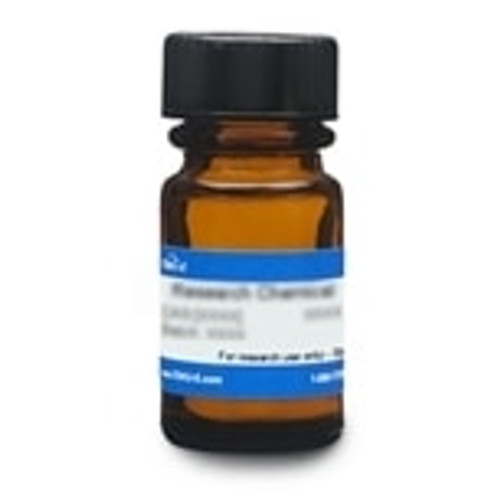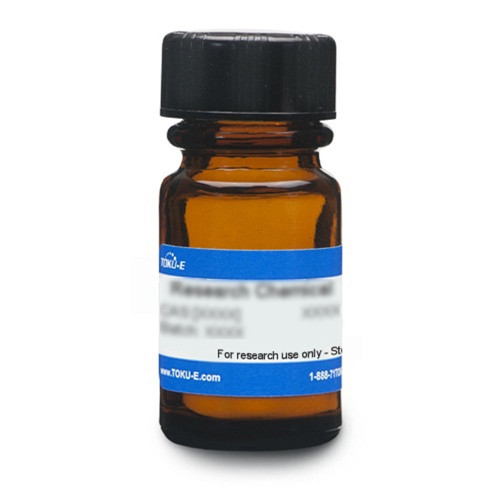Quinine Hydrochloride is a naturally occurring alkaloid, and potassium channel blocker. It is a stereoisomer of quinidine which contains an aromatic quinoline and a bicyclic quinuclidine. It was first isolated from the bark of a cinchona tree in 1820.
Quinine Hydrochloride is commonly used in sensory evaluation experiments in food science as a standard for bitterness. In fact, Quinine is the ingredient in tonic water that gives it its bitter taste. Bark extracts have been used to treat malaria since 1632 (Sullivan, 2011) and Quinine was the first compound used to treat malaria (Achan J et al, 2011). Quinine is used as a chiral catalyst backbone.
We also offer:
| Mechanism of Action |
The mechanism of action of Quinine has not been fully resolved. A closely related compound chloroquine, is toxic to parasites by inhibiting hemozoin biocrystallization in the heme detoxification pathway, which allows buildup of cytotoxic heme which accumulates and results in parasite death. The iron-containing molecule heme is the toxic byproduce of hemoglobin digestion. |
| Spectrum | Parasites. Antimalarial. |
| Insect Biology | The iron-containing molecule heme is the toxic byproduct of hemoglobin digestion. Authors reviewed in vivo rates of heme crystallization in the malaria parasite and results were consistent with a model for crystallization via the heme detoxification protein. Research suggests there is a relationship between hemoglobin digestion and heme crystallization which can be explored for compound development (Kapishnikov et al, 2017). |
| Eukaryotic Cell Culture Applications |
Quinine can be used as a positive control for in vitro phototoxicity testing with celluar models for preclinical testing. The 3T3 neutral red uptake phototoxicity testing with HaCaT human keratinocyte cell line and UVA/UVB radiation based on the 3T3 neutral red uptake phototoxicity test (NRU PT) was studied as part of cosmetic/pharmaceutical formulation testing (Maciel et al, 2022). Cytotoxicity is evaluated considering the reduction in vitral dye update (neutral red) by dead or damaged cells. Quinine Hydrochloride can be used in aptamer engineering. Aptamers are nucleic acid structures that form binding pockets for their target ligands, and have applications in synthetic biology and gene therapy. Many naturally occuring RNA aptamers are components of roboswitches (noncoding RNA gene regulatory devices containing an expression platform). . Researchers developed a 'Graftamer' approach, an experimental platform exploring the architecture of a natural riboswitch to enhance in vitro aptamer selection. Authors discovered aptamers for Quinine that seem to maintain the structural features of the natural guanine riboswitch aptamer. Quinine aptamers were grafted onto this platform and found these aptamers function in cells (Mohsen et al, 2023). |
| Molecular Formula | C20H24N2O2 ∙ HCl |
| References |
Achan J et al (2011) Quinine, an old anti-malarial drug in a modern world: role in the treatment of malaria. Malar. J 10:144 PMID 21609473 Hansen JL, Reed DR, Wright MJ, Martin NG and Breslin PA (2006) Heritability and genetic covariation of sensitivity to PROP, SOA, quinine HCl, and caffeine. Chem Senses Vol 31(5):403-413 PMID 16527870 Chang WI, Chung JW, Kim YK, Chung SC and Kho HS (2006) The relationship between phenylthicarbamide (PTC) and 6-n-propylthiouracil (PROP) taster status and taste thresholds for sucrose and quinine. Arch. Oral Biol. 51(5):427-432 PMID 16297856 Holfels E et al (1994) In vitro effects of artemisinin ether, cycloguanil hydrochloride (alone and in combination with sulfadiazine), quinine sulfate, mefloquine, primaquine phosphate, trifluoperazine hydrochloride, and verapamil on Toxoplasma gondii. Antimicrob. Agents and Chemother 38 (6):1392–1396 PMID 8092843 Kapishnikov S et al (2017) Unraveling heme detoxification in the malaria parasite by in situ correlative X-ray fluorescense microscopy and soft X-ray tomography. Sci. Rep. 7:7610 Kingston DGI, Cassera, MB (2022). Antimalarial Natural Products. In: Kinghorn, A.D., Falk, H., Gibbons, S., Asakawa, Y., Liu, JK., Dirsch, V.M. (eds) Antimalarial Natural Products. Progress in the chemistry of organic natural products, vol 117. Springer, Cham. Lakowicz JR (2006) Instrumentation for fluorescence spectroscopy. In: Principles of fluorescence spectroscopy. 3rd ed. Springer-Verlag pp. 54 Maciel B et al (2019) Implementation of an in vitro methodology for phototoxicity evaluation in a human keratinocyte cell line. Toxicol In Vitro. 61:104618 PMID 31381965 Mohsen MG, Midy MK, Balaji A, Breaker RR (2023) Exploiting natural riboswitches for aptamer engineering and validation. Nucleic Acids Res. 51(2):966-981 PMID: 36617976 Sullivan, DJ (2011) Cinchona Alkaloids: Quinine and Quinidine. In: Treatment and prevention of malaria: Antimalarial drug chemistry, action and used by Staines HM and Krishna S. Springer Basel pp. 45-65 |







